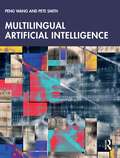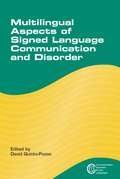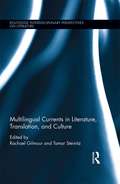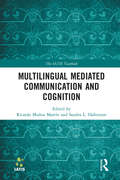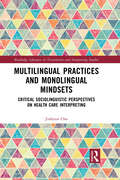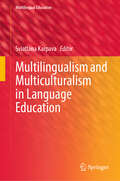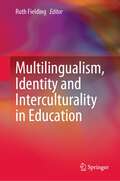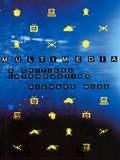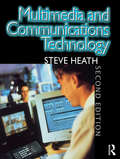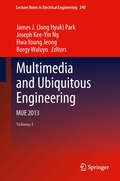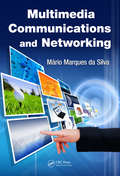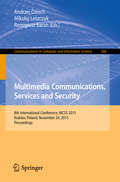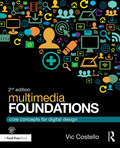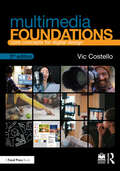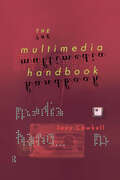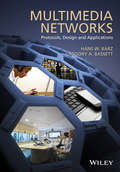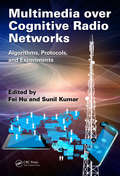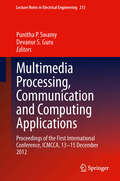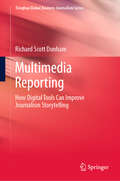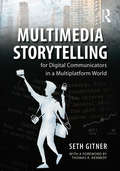- Table View
- List View
Multilingual Artificial Intelligence
by Peng Wang Pete SmithMultilingual Artificial Intelligence is a guide for non-computer science specialists and learners looking to explore the implementation of AI technologies to solve real-life problems involving language data.Focusing on multilingual, multicultural, pre-trained large language models and their practical use through fine-tuning and prompt engineering, Wang and Smith demonstrate how to apply this new technology in areas such as information retrieval, semantic webs, and retrieval augmented generation, to improve both human productivity and machine intelligence. Finally, they discuss the human impact of language technologies in the cultural context, and provide an AI competence framework for users to design their own learning journey.This innovative text is essential reading for all students, professionals, and researchers in language, linguistics, and related areas looking to understand how to integrate multilingual and multicultural artificial intelligence technology into their research and practice.
Multilingual Aspects of Signed Language Communication and Disorder
by David Quinto-PozosInquiry into signed languages has added to what is known about structural variation and language, language learning, and cognitive processing of language. However, comparatively little research has focused on communication disorders in signed language users. For some deaf children, atypicality is viewed as a phase that they will outgrow, and this results in late identification of linguistic or cognitive deficits that might have been addressed earlier. This volume takes a step towards describing different types of atypicality in language communicated in the signed modality such as linguistic impairment caused by deficits in visual processing, difficulties with motor movements, and neurological decline. Chapters within the book also consider communication differences in hearing children acquiring signed and spoken languages.
Multilingual Crisis Communication: Insights from China (The IATIS Yearbook)
by Jia Li Jie ZhangMultilingual Crisis Communication is the first book to explore the lived experiences of linguistic minorities in crisis-affected settings in the Global South, particularly during the Covid-19 pandemic. China has been selected as a case of inquiry for multilingual crisis communication because of its high level of linguistic diversity. Taking up critical sociopolitical approaches, this book conceptualizes multilingual crisis communication from three dimensions: identifying communication barriers, engaging communication repertoires, and empowering communication justice.Comprising eight main chapters, along with an introduction and an epilogue, this edited book is divided into three parts in terms of the demographic and social conditions of linguistic minorities, as indigenous, migrant, and those with communicative disabilities. This book brings together a range of critical perspectives of sociolinguistic scholars, language teachers, and public health workers. Each team of authors includes at least one member of the research community with many years of field work experience, and some of them belong to ethnic minorities. These studies can generate new insights for enhancing the accessibility and effectiveness of multilingual crisis communication.This book will be of interest to academics and postgraduate students in the fields of multilingualism, intercultural communication, translation and interpreting studies, and public health policy.
Multilingual Currents in Literature, Translation and Culture (Routledge Interdisciplinary Perspectives on Literature)
by Rachael Gilmour Tamar SteinitzAt a time increasingly dominated by globalization, migration, and the clash between supranational and ultranational ideologies, the relationship between language and borders has become more complicated and, in many ways, more consequential than ever. This book shows how concepts of ‘language’ and ‘multilingualism’ look different when viewed from Belize, Lagos, or London, and asks how ideas about literature and literary form must be remade in a contemporary cultural marketplace that is both linguistically diverse and interconnected, even as it remains profoundly unequal. Bringing together scholars from the fields of literary studies, applied linguistics, publishing, and translation studies, the volume investigates how multilingual realities shape not only the practice of writing but also modes of literary and cultural production. Chapters explore examples of literary multilingualism and their relationship to the institutions of publishing, translation, and canon-formation. They consider how literature can be read in relation to other multilingual and translational forms of contemporary cultural circulation and what new interpretative strategies such developments demand. In tracing the multilingual currents running across a globalized world, this book will appeal to the growing international readership at the intersections of comparative literature, world literature, postcolonial studies, literary theory and criticism, and translation studies.
Multilingual Mediated Communication and Cognition (The IATIS Yearbook)
by Ricardo Muñoz Martín; Sandra L. HalversonThis collection provides a snapshot of cutting-edge research in the rapidly developing area of cognitive approaches to multilingual mediated communication. The chapters cover important trends in current work, including: the increasing interaction between translation and interpreting research, the emergence of neuroscientific theories and methods, the role of emotion in translation processes, and the impact of cognitive aptitudes on translation performance. Exploring the interface with neighbouring research areas such as bilingualism, reading, and cognitive psychology, the book presents a variety of theoretical frameworks and constructs to support empirical research and theoretical development. The authors address new research areas, such as emotions and multisensory integration; apply new research constructs, such as eye-voice span; and expand the scope of cognitive translation studies to include agents other than the mediator. Documenting the growth in breadth and depth within cognitive translation and interpreting studies (CTIS) over the past decade, this is essential reading for all advanced students and researchers needing an up-to-date overview of cognitive translation and interpreting studies.
Multilingual Practices and Monolingual Mindsets: Critical Sociolinguistic Perspectives on Health Care Interpreting (Routledge Advances in Translation and Interpreting Studies)
by Jinhyun ChoFocusing on health care interpreting in Australia, this book examines the under-recognition of interpreting from a critical sociolinguistic perspective encompassing language, race and class.Interpreters play an important role in promoting diversity and inclusion but why is interpreting not properly recognised? Cho grapples with this question by focusing readers’ attention to developments in interpreting following increased migration in an English-monolingual Australia, a context in which other languages and speakers have been historically under-valued. Through compelling analysis and the voices of health care interpreters in Australia, this groundbreaking book explores how issues with interpreting are fundamentally issues of justice that affect minority languages and their speakers. Covering diverse professional and social spaces of interpreting, the book discovers linguistic, racial and class hierarchies embedded in English monolingualism and their impact on multilingual practices and populations. From both historical and contemporary perspectives, the book critically investigates monolingual practices from the past and tensions between enduring monolingual ideologies and multilingual realities, suggesting specific ways to overcome monolingual mindsets to make societies more inclusive.This volume will be of interest to students and scholars in interpreting studies, health communication, intercultural communication and sociolinguistics.
Multilingualism and Multiculturalism in Language Education (Multilingual Education #49)
by Sviatlana KarpavaThis volume focuses on multidisciplinary approaches to multilingualism, multiculturalism and language teaching and learning at (pre)primary, secondary and tertiary levels. It addresses both top-down and bottom-up perspectives on language education policies, teacher training and preparation. The book explores the needs and challenges related to education in multilingual classrooms, the relationship between parents and educators, and linguistic and cultural diversity in classrooms. It draws on the findings of research that has been conducted worldwide including in Cyprus, USA, UK, Scotland, Spain, France, Sri Lanka, Slovenia, Australia, New Zealand, Indonesia, Hong Kong, Sweden, Greece, and Italy. This book is ideal for students of (applied) linguistics, (socio)linguistics, psycholinguistics, language acquisition and education, as well as practitioners, teachers, parents, experts and researchers wishing to update their knowledge regarding multilingualism, multiculturalism, language learning, and teaching.
Multilingualism, Identity and Interculturality in Education
by Ruth FieldingThis book brings together research on multilingualism, identity and intercultural understanding from a range of locations across the globe to explore the intersection of these key ideas in education. It addresses the need to better understand how multilingual, identity, and intercultural approaches intersect for multilingual learners in complex and varied settings. Through global examples, it explores how identities and multilingualism are situated within, and surrounding intercultural experiences. This book examines the different theoretical interpretations as encountered and used in different contexts. By doing so, it helps readers better understand how teachers approach multilingualism and diversity in a range of contexts.
Multimedia: A Critical Introduction
by Richard WiseMultimedia: A Critical Introduction is a comprehensive guide to the new media form which has resulted from the application of computer technology to existing techniques of broadcasting and telecommunications transmission. The rapid growth of multimedia technologies such as the internet, e-mail and digital television holds the promise of a new 'information age' in which individual tastes are catered for, citizens become better informed, and new wealth is created. But are new media technologies really designed to achieve these utopian aims?Multimedia: a critical introduction provides a historical, cultural and political context to the development of multimedia, as both a technology and a concept. Individual chapters address:* the origins of multimedia in the unlikely interaction between the military and 1960s counter-culture: how the phenomenal US budgets allocated to US military research resulted in the microchip, and why the efforts of counter-culture computer hobbyists evolved into a multi-billion dollar industry.*the wider democratic and cultural implications of multimedia in the wake of the deregulation of the media industries by 'new right' governments in the 1980s, which has led to the domination of the media by transnational conglomerates.* issues of privacy and censorship in relation to new media, including discussion of cryptography, electronic surveillance, and attempts to regulate material such as pornography on the internet.* the use of digital technology to create special effects in feature films.
Multimedia and Communications Technology
by Steve HeathMultimedia and Communications Technology is a practical explanation of the technologies that bring together existing products such as the PC, telephone and television. It is precisely this revolution that the book addresses - offering an up to date technical overview of developments in PC technology, video and audio compression, telecommunications and many other disciplines. Written as a series of tutorials, the book starts with the fundamental techniques of digital audio and video, moving on to compression techniques such as JPEG and MPEG. The delivery systems for multimedia are then covered, starting with the CD and on to telephones, local and wide area networks and ATM and ASDL. The final chapters describe how these technologies are brought together in some key applications:· video conferencing· digital video broadcasting· video on demand · interactive televisionSteve Heath is responsible for European Strategy and Technology Development at Motorola. He has had many years experience in computer design and has presented papers on multimedia technology at international conferences. He is a well known technical writer and has written fourteen other books for Focal Press, Newnes and Butterworth-Heinemann.
Multimedia and Image Management: Activities
by Susan E. L. Lake Karen BeanMost of the applications discussed within this book are available for both the Windows and Macintosh operating systems, and the activities described can be worked easily on either system.
Multimedia and Ubiquitous Engineering
by Borgy Waluyo Hwa Young Jeong James J. Park Joseph Kee-Yin NgThe new multimedia standards (for example, MPEG-21) facilitate the seamless integration of multiple modalities into interoperable multimedia frameworks, transforming the way people work and interact with multimedia data. These key technologies and multimedia solutions interact and collaborate with each other in increasingly effective ways, contributing to the multimedia revolution and having a significant impact across a wide spectrum of consumer, business, healthcare, education, and governmental domains. Multimedia and Ubiquitous Engineering provides an opportunity for academic and industry professionals to discuss recent progress in the area of multimedia and ubiquitous environment including models and systems, new directions, novel applications associated with the utilization and acceptance of ubiquitous computing devices and systems.
Multimedia Communications and Networking
by Mario Marques da SilvaThe result of decades of research and international project experience, Multimedia Communications and Networking provides authoritative insight into recent developments in multimedia, digital communications, and networking services and technologies. Supplying you with the required foundation in these areas, it illustrates the means that will allow
Multimedia Communications, Services and Security
by Remigiusz Baran Mikołaj Leszczuk Andrzej DziechThis volume constitutes the refereed proceedings of the 8th International Conference on Multimedia Communications, Services and Security, MCSS 2015, held in Krakow, Poland, in November 2015. The 16 full papers included in the volume were selected from 39 submissions. The papers cover ongoing research activities in the following topics: multimedia services; intelligent monitoring; audio-visual systems; biometric applications; experiments and deployments.
Multimedia Foundations
by Vic CostelloUnderstand the core concepts and skills of multimedia production and digital storytelling using text, graphics, photographs, sound, motion, and video. Then, put it all together using the skills that you have developed for effective project planning, collaboration, visual communication, and graphic design. Presented in full color with hundreds of vibrant illustrations, "Multimedia Foundations" trains you in the principles and skill sets common to all forms of digital media production, enabling you to create successful, engaging content, no matter what tools you are using. Companion website features a wealth of web resources, illustrations, and video tutorials demonstrating the key techniques presented in the book. Improve projects with core principles of visual communication and graphic design. Learn necessary strategies for project planning, organization, and asset management. Understand the intricacy of design and production workflows. Effectively navigate postproduction and the distribution of multimedia content. Utilize the companion web site video tutorials and links to go along with each of the chapters.
Multimedia Foundations
by Vic CostelloUnderstand the core concepts and skills of multimedia production and digital storytelling using text, graphics, photographs, sound, motion, and video. Then, put it all together using the skills that you have developed for effective project planning, collaboration, visual communication, and graphic design. Presented in full color with hundreds of vibrant illustrations, "Multimedia Foundations" trains you in the principles and skill sets common to all forms of digital media production, enabling you to create successful, engaging content, no matter what tools you are using. Companion website features a wealth of web resources, illustrations, and video tutorials demonstrating the key techniques presented in the book. Improve projects with core principles of visual communication and graphic design. Learn necessary strategies for project planning, organization, and asset management. Understand the intricacy of design and production workflows. Effectively navigate postproduction and the distribution of multimedia content. Utilize the companion web site video tutorials and links to go along with each of the chapters.
Multimedia Foundations: Core Concepts for Digital Design
by Vic CostelloUnderstand the core concepts and skills of multimedia production and digital storytelling using text, graphics, photographs, sound, motion, and video. Then, put it all together using the skills that you have developed for effective project planning, collaboration, design, and production. Presented in full color with hundreds of vibrant illustrations, Multimedia Foundations, Second Edition trains you in the principles and skill sets common to all forms of digital media production, enabling you to create successful, engaging content, no matter what tools you are using. The second edition has been fully updated and features a new chapter on video production and new sections on user-centered design, digital cinema standards (2K, 4K, and 8K video), and DSLR and video camcorder recording formats and device settings. The companion website, which features a wealth of web resources, glossary terms, and video tutorials, has also been updated with new content for both students and instructors.
Multimedia Foundations: Core Concepts for Digital Design
by Vic CostelloWhether you are working using text, graphics, photography, sound, motion, or video, Multimedia Foundations covers the skills necessary to be an effective modern storyteller. Presented in full color with hundreds of vibrant illustrations, this book trains readers in the principles and skills common to all forms of digital media production, enabling the creation of successful, engaging content, no matter what tools are used. Chapters feature useful exercises to cement core concepts and help readers develop planning, collaboration, design, and production skills. This third edition has been fully updated and includes new and revised illustrations, updated coverage of digital asset management and media workflows, a completely rewritten chapter on coding for web and mobile media, and new sections on design thinking, inclusive design, color theory, photography composition, interview and B-roll acquisition techniques, and editing stages and postproduction workflows. Multimedia Foundations is a comprehensive resource for students in fields such as journalism, film production, animation and game design, web and graphic design, and other areas where modern media is produced. A website with Instructor and Student Resources for this book includes a glossary of terms, chapter PowerPoints, and sample text banks.
The Multimedia Handbook
by Tony CawkellThe Multimedia Handbook provides a comprehensive guide to the wide range of uses of multimedia. The first part of the book introduces the technology for the non-specialist. Part Two covers multimedia applications and markets. Tony Cawkell details the huge array of authoring software which is now available, as well as the distribution of multimedia data by telephone, cable, satellite or radio communications. There is an extensive bibliography, a glossary of technical terms and acronyms and a full index.
Multimedia Networks
by Hans W. Barz Gregory A. BassettThe transportation of multimedia over the network requires timely and errorless transmission much more strictly than other data. This had led to special protocols and to special treatment in multimedia applications (telephony, IP-TV, streaming) to overcome network issues. This book begins with an overview of the vast market combined with the user's expectations. The base mechanisms of the audio/video coding (H.26x etc.) are explained to understand characteristics of the generated network traffic. Further chapters treat common specialized underlying IP network functions which cope with multimedia data in conjunction which special time adaption measures. Based on those standard functions these chapters can treat uniformly SIP, H.248, High-End IP-TV, Webcast, Signage etc. A special section is devoted to home networks which challenge high-end service delivery due to possibly unreliable management. The whole book treats concepts described in accessible IP-based standards and which are implemented broadly. The book is aimed at graduate students/practitioners with good basic knowledge in computer networking. It provides the reader with all concepts of currently used IP technologies of how to deliver multimedia efficiently to the end user.
Multimedia over Cognitive Radio Networks: Algorithms, Protocols, and Experiments
by Fei Hu Sunil KumarWith nearly 7 billion mobile phone subscriptions worldwide, mobility and computing have become pervasive in our society and business. Moreover, new mobile multimedia communication services are challenging telecommunication operators. To support the significant increase in multimedia traffic-especially video-over wireless networks, new technological
Multimedia Processing, Communication and Computing Applications: Proceedings of the First International Conference, ICMCCA, 13-15 December 2012
by Devanur S. Guru Punitha P. SwamyICMCCA 2012 is the first International Conference on Multimedia Processing, Communication and Computing Applications and the theme of the Conference is chosen as 'Multimedia Processing and its Applications'. Multimedia processing has been an active research area contributing in many frontiers of today's science and technology. This book presents peer-reviewed quality papers on multimedia processing, which covers a very broad area of science and technology. The prime objective of the book is to familiarize readers with the latest scientific developments that are taking place in various fields of multimedia processing and is widely used in many disciplines such as Medical Diagnosis, Digital Forensic, Object Recognition, Image and Video Analysis, Robotics, Military, Automotive Industries, Surveillance and Security, Quality Inspection, etc. The book will assist the research community to get the insight of the overlapping works which are being carried out across the globe at many medical hospitals and institutions, defense labs, forensic labs, academic institutions, IT companies and security & surveillance domains. It also discusses latest state-of-the-art research problems and techniques and helps to encourage, motivate and introduce the budding researchers to a larger domain of multimedia.
Multimedia Reporting: How Digital Tools Can Improve Journalism Storytelling (Tsinghua Global Business Journalism Series)
by Richard Scott DunhamThis is the first book to apply multimedia tools to economic and business storytelling. By examining the journalism essentials as well as the advanced multimedia skills, it helps readers use the latest technological tools to integrate multimedia elements into traditional news coverage. It also explains how to tell stories solely through multimedia elements. The new language of online journalism includes writing for digital platforms, writing blogs and writing for social media and involves a wide range of multimedia skills, like video, audio, photography, graphics, data visualization and animation. Multimedia journalism allows a two-way communication with the audience that was not possible in traditional “legacy” media, and this textbook is replete with links to useful tutorials, examples of award-winning multimedia stories, and advanced digital resources, offering journalists a road map to the brave new world of digital reporting and editing.
Multimedia Semantics
by Simon Schenk Raphael Troncy Benoit HuetIn this book, the authors present the latest research results in the multimedia and semantic web communities, bridging the "Semantic Gap"This book explains, collects and reports on the latest research results that aim at narrowing the so-called multimedia "Semantic Gap": the large disparity between descriptions of multimedia content that can be computed automatically, and the richness and subjectivity of semantics in user queries and human interpretations of audiovisual media. Addressing the grand challenge posed by the "Semantic Gap" requires a multi-disciplinary approach (computer science, computer vision and signal processing, cognitive science, web science, etc.) and this is reflected in recent research in this area. In addition, the book targets an interdisciplinary community, and in particular the Multimedia and the Semantic Web communities. Finally, the authors provide both the fundamental knowledge and the latest state-of-the-art results from both communities with the goal of making the knowledge of one community available to the other.Key Features:Presents state-of-the art research results in multimedia semantics: multimedia analysis, metadata standards and multimedia knowledge representation, semantic interaction with multimediaContains real industrial problems exemplified by user case scenariosOffers an insight into various standardisation bodies including W3C, IPTC and ISO MPEGContains contributions from academic and industrial communities from Europe, USA and AsiaIncludes an accompanying website containing user cases, datasets, and software mentioned in the book, as well as links to the K-Space NoE and the SMaRT society web sites (http://www.multimediasemantics.com/)This book will be a valuable reference for academic and industry researchers /practitioners in multimedia, computational intelligence and computer science fields. Graduate students, project leaders, and consultants will also find this book of interest.
Multimedia Storytelling for Digital Communicators in a Multiplatform World
by Seth GitnerMultimedia Storytelling for Digital Communicators in a Multiplatform World is a unique guide for all students who need to master visual communication through multiple media and platforms. Every communication field now requires students to be fluent in visual storytelling skill sets, and as the present-day media adapt to a multiplatform world (with ever-increasing delivery systems from desktops to cell phones), students specializing in different forms of communication are discovering the power of merging new multimedia technology with very old and deep-rooted storytelling concepts. Award-winning journalist and multimedia professor Seth Gitner provides students with the tools for successfully realizing this merger, from understanding conflict, characters, and plot development to conducting successful interviews, editing video in post-production, and even sourcing royalty-free music and sound effects. Incorporating how-to’s on everything from website and social media optimization to screenwriting, Multimedia Storytelling aims to be a resource for any student who needs to think and create visually, in fields across broadcast and digital journalism, film, photography, advertising, and public relations. The book also includes a range of supplemental material, including wide-ranging skills exercises for each chapter, interviews with seasoned professionals, key terms, and review questions.
